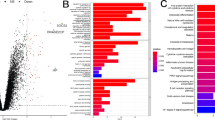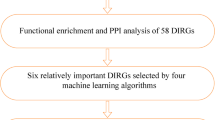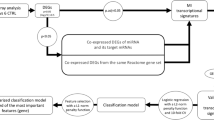Abstract
Patients diagnosed with stable coronary artery disease (CAD) are at continued risk of experiencing acute myocardial infarction (AMI). This study aims to unravel the pivotal biomarkers and dynamic immune cell changes, from an immunological, predictive, and personalized viewpoint, by implementing a machine-learning approach and a composite bioinformatics strategy. Peripheral blood mRNA data from different datasets were analyzed, and CIBERSORT was used for deconvoluting human immune cell subtype expression matrices. Weighted gene co-expression network analysis (WGCNA) in single-cell and bulk transcriptome levels was conducted to explore possible biomarkers for AMI, with a particular emphasis on examining monocytes and their involvement in cell-cell communication. Unsupervised cluster analysis was performed to categorize AMI patients into different subtypes, and machine learning methods were employed to construct a comprehensive diagnostic model to predict the occurrence of early AMI. Finally, RT-qPCR on peripheral blood samples collected from patients validated the clinical utility of the machine learning-based mRNA signature and hub biomarkers. The study identified potential biomarkers for early AMI, including CLEC2D, TCN2, and CCR1, and found that monocytes may play a vital role in AMI samples. Differential analysis revealed that CCR1 and TCN2 exhibited elevated expression levels in early AMI compared to stable CAD. Machine learning methods showed that the glmBoost+Enet [alpha=0.9] model achieved high predictive accuracy in the training set, external validation sets, and clinical samples in our hospital. The study provided comprehensive insights into potential biomarkers and immune cell populations involved in the pathogenesis of early AMI. The identified biomarkers and the constructed comprehensive diagnostic model hold great promise for predicting the occurrence of early AMI and can serve as auxiliary diagnostic or predictive biomarkers.








Similar content being viewed by others
Data availability
The following information was supplied regarding data availability: Data is available at GEO database (https://www.ncbi.nlm.nih.gov/geo/).
References
Akram IG, Georges R, Hielscher T, Adwan H, Berger MR (2016) The chemokines CCR1 and CCRL2 have a role in colorectal cancer liver metastasis. Tumour Biol 37:2461–2471
Aydin S, Ugur K, Aydin S, Sahin I, Yardim M (2019) Biomarkers in acute myocardial infarction: current perspectives. Vasc Health Risk Manag 15:1–10
Boachie J, Adaikalakoteswari A, Goljan I, Samavat J, Cagampang FR, Saravanan P (2021) Intracellular and tissue levels of vitamin B12 in hepatocytes are modulated by CD320 receptor and TCN2 transporter. Int J Mol Sci 22(6):3089. https://doi.org/10.3390/ijms22063089
Boles KS, Barten R, Kumaresan PR, Trowsdale J, Mathew PA (1999) Cloning of a new lectin-like receptor expressed on human NK cells. Immunogenetics 50:1–7
Boyum A (1968) Separation of leukocytes from blood and bone marrow. Introduction. Scand J Clin Lab Invest Suppl 97:7
Buller CW, Mathew PA, Mathew SO (2020) Roles of NK cell receptors 2B4 (CD244), CS1 (CD319), and LLT1 (CLEC2D) in cancer. Cancers (Basel) 12
Cheng JF, Jack R (2008) CCR1 antagonists. Mol Divers 12:17–23
Damas JK, Eiken HG, Oie E, Bjerkeli V, Yndestad A, Ueland T, Tonnessen T, Geiran OR, Aass H, Simonsen S, Christensen G, Froland SS, Attramadal H, Gullestad L, Aukrust P (2000) Myocardial expression of CC- and CXC-chemokines and their receptors in human end-stage heart failure. Cardiovasc Res 47:778–787
Feng S, Xia T, Ge Y, Zhang K, Ji X, Luo S, Shen Y (2022a) Computed tomography imaging-based radiogenomics analysis reveals hypoxia patterns and immunological characteristics in ovarian cancer. Front Immunol 13:868067
Feng S, Xu Y, Dai Z, Yin H, Zhang K, Shen Y (2022c) Integrative analysis from multicenter studies identifies a WGCNA-derived cancer-associated fibroblast signature for ovarian cancer. Front Immunol 13:951582
Feng S, Yin H, Zhang K, Shan M, Ji X, Luo S, Shen Y (2022b) Integrated clinical characteristics and omics analysis identifies a ferroptosis and iron-metabolism-related lncRNA signature for predicting prognosis and therapeutic responses in ovarian cancer. J Ovarian Res 15:10
Ford TJ, Corcoran D, Berry C (2018) Stable coronary syndromes: pathophysiology, diagnostic advances and therapeutic need. Heart 104:284–292
Germain C, Bihl F, Zahn S, Poupon G, Dumaurier MJ, Rampanarivo HH, Padkjaer SB, Spee P, Braud VM (2010) Characterization of alternatively spliced transcript variants of CLEC2D gene. J Biol Chem 285:36207–36215
Graham IM, Di Angelantonio E, Visseren F, De Bacquer D, Ference BA, Timmis A, Halle M, Vardas P, Huculeci R, Cooney MT, C. European Society of Cardiology Cardiovascular Risk (2021) Systematic Coronary Risk Evaluation (SCORE): JACC focus seminar 4/8. J Am Coll Cardiol 77:3046–3057
Hua Y, Yin H, Liu X, Xie J, Zhan W, Liang G, Shen Y (2022) Salt-inducible kinase 2-triggered release of its inhibitor from hydrogel to suppress ovarian cancer metastasis. Adv Sci (Weinh) 9:e2202260
Iannattone PA, Zhao X, VanHouten J, Garg A, Huynh T (2020) Artificial intelligence for diagnosis of acute coronary syndromes: a meta-analysis of machine learning approaches. Can J Cardiol 36:577–583
Jin S, Guerrero-Juarez CF, Zhang L, Chang I, Ramos R, Kuan CH, Myung P, Plikus MV, Nie Q (2021) Inference and analysis of cell-cell communication using CellChat. Nat Commun 12:1088
Johansson S, Rosengren A, Young K, Jennings E (2017) Mortality and morbidity trends after the first year in survivors of acute myocardial infarction: a systematic review. BMC Cardiovasc Disord 17:53
Kanehisa M, Goto S (2000) KEGG: Kyoto Encyclopedia of Genes and Genomes. Nucleic Acids Res 28:27–30
Kaya Z, Goser S, Buss SJ, Leuschner F, Ottl R, Li J, Volkers M, Zittrich S, Pfitzer G, Rose NR, Katus HA (2008) Identification of cardiac troponin I sequence motifs leading to heart failure by induction of myocardial inflammation and fibrosis. Circulation 118:2063–2072
Keeter WC, Moriarty AK, Akers R et al (2023) Neutrophil-specific STAT4 deficiency attenuates atherosclerotic burden and improves plaque stability via reduction in neutrophil activation and recruitment into aortas of Ldlr-/- mice. https://doi.org/10.1101/2023.02.22.529608
Langfelder P, Horvath S (2008) WGCNA: an R package for weighted correlation network analysis. BMC Bioinformatics 9:559
Layden AJ, O'Brien KO, Pressman EK, Cooper EM, Kent TR, Finkelstein JL (2016) Vitamin B12 and placental expression of transcobalamin in pregnant adolescents. Placenta 45:1–7
Lee MS, Dahodwala MQ (2015) Percutaneous coronary intervention for acute myocardial infarction due to unprotected left main coronary artery occlusion: status update 2014. Catheter Cardiovasc Interv 85:416–420
Liehn EA, Merx MW, Postea O, Becher S, Djalali-Talab Y, Shagdarsuren E, Kelm M, Zernecke A, Weber C (2008) Ccr1 deficiency reduces inflammatory remodelling and preserves left ventricular function after myocardial infarction. J Cell Mol Med 12:496–506
Liu ZY, Liu F, Cao Y, Peng SL, Pan HW, Hong XQ, Zheng PF (2023) ACSL1, CH25H, GPCPD1, and PLA2G12A as the potential lipid-related diagnostic biomarkers of acute myocardial infarction. Aging (Albany NY) 15
Nayci AE, Dogan S (2022) Are the cytokines and chemokines important for the early diagnosis of mesenteric ischemia? Ulus Travma Acil Cerrahi Derg 29:17–21
Polytarchou K, Dimitroglou Y, Varvarousis D, Christodoulis N, Psachoulia C, Pantziou C, Mourouzis I, Pantos C, Manolis AS (2020) Methylmalonic acid and vitamin B12 in patients with heart failure. Hellenic J Cardiol 61:330–337
Shao C, Wang J, Tian J, Tang YD (2020) Coronary artery disease: from mechanism to clinical practice. Adv Exp Med Biol 1177:1–36
Shen X, Yang Z, Feng S, Li Y (2021) Identification of uterine leiomyosarcoma-associated hub genes and immune cell infiltration pattern using weighted co-expression network analysis and CIBERSORT algorithm. World J Surg Oncol 19:223
Soehnlein O, Drechsler M, Doring Y, Lievens D, Hartwig H, Kemmerich K, Ortega-Gomez A, Mandl M, Vijayan S, Projahn D, Garlichs CD, Koenen RR, Hristov M, Lutgens E, Zernecke A, Weber C (2013) Distinct functions of chemokine receptor axes in the atherogenic mobilization and recruitment of classical monocytes. EMBO Mol Med 5:471–481
Song Z, Gao P, Zhong X, Li M, Wang M, Song X (2022) Identification of five hub genes based on single-cell RNA sequencing data and network pharmacology in patients with acute myocardial infarction. Front Public Health 10:894129
Vance BA, Harley PH, Backlund PS, Ward Y, Phelps TL, Gress RE (2005) Human CD69 associates with an N-terminal fragment of calreticulin at the cell surface. Arch Biochem Biophys 438:11–20
Wolf D, Ley K (2019) Immunity and inflammation in atherosclerosis. Circ Res 124:315–327
Wu Y, Jiang T, Hua J, Xiong Z, Chen H, Li L, Peng J, Xiong W (2022) Integrated bioinformatics-based analysis of hub genes and the mechanism of immune infiltration associated with acute myocardial infarction. Front Cardiovasc Med 9:831605
Yeboah J, Young R, McClelland RL, Delaney JC, Polonsky TS, Dawood FZ, Blaha MJ, Miedema MD, Sibley CT, Carr JJ, Burke GL, Goff DC Jr, Psaty BM, Greenland P, Herrington DM (2016) Utility of nontraditional risk markers in atherosclerotic cardiovascular disease risk assessment. J Am Coll Cardiol 67:139–147
Yuan S, Mason AM, Carter P, Burgess S, Larsson SC (2021) Homocysteine, B vitamins, and cardiovascular disease: a Mendelian randomization study. BMC Med 19:97
Funding
This research was supported by Zhejiang Provincial Natural Science Foundation of China (no. LGF21H0200062023), Zhejiang Province Traditional Chinese Medicine Scientific Research Fund (2023ZL700), Jiaxing Key Laboratory of Arteriosclerotic Diseases (2020-dmzdsys), Pioneer innovation team of Jiaxing Institute of Arteriosclerotic Disease (XFCX-DMYH), and Jiaxing First Hospital independent research project (ZZKT2022-001, ZZKT2022-003, ZZKT2022-004, ZZKT2022-005, ZZKT2022-007, ZZKT2022-008).
Author information
Authors and Affiliations
Contributions
Na Yuan and Ling-Yan He conceived and designed the study.
Hai-Hua Pan was responsible for materials.
Hai-Hua Pan drafted the article.
Jia-Lin Sheng, Hui-Lin Hu, and Chang-Lin Zhai revised the article critically.
All authors had final approval of the submitted versions.
Corresponding authors
Ethics declarations
Ethics approval and consent to participate
This research was approved by the Ethics Committee of the First Hospital of Jiaxing Affiliated Hospital of Jiaxing University (2022-LY-002). Written informed consent was obtained from all participants.
Consent for publication
Not applicable
Conflict of interest
The authors declare no competing interests.
Additional information
Publisher’s note
Springer Nature remains neutral with regard to jurisdictional claims in published maps and institutional affiliations.
Rights and permissions
Springer Nature or its licensor (e.g. a society or other partner) holds exclusive rights to this article under a publishing agreement with the author(s) or other rightsholder(s); author self-archiving of the accepted manuscript version of this article is solely governed by the terms of such publishing agreement and applicable law.
About this article
Cite this article
Pan, HH., Yuan, N., He, LY. et al. Machine learning-based mRNA signature in early acute myocardial infarction patients: the perspective toward immunological, predictive, and personalized. Funct Integr Genomics 23, 160 (2023). https://doi.org/10.1007/s10142-023-01081-5
Received:
Revised:
Accepted:
Published:
DOI: https://doi.org/10.1007/s10142-023-01081-5




